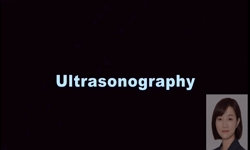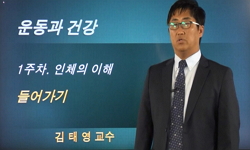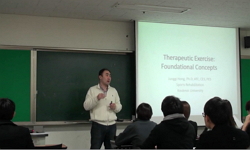Objective To investigate the changes of activation of the abdominal muscles depending on exercise angles and whether the activation of rectus abdominis differs according to the location, during curl up and leg raise exercises, by measuring the thickne...
http://chineseinput.net/에서 pinyin(병음)방식으로 중국어를 변환할 수 있습니다.
변환된 중국어를 복사하여 사용하시면 됩니다.
- 中文 을 입력하시려면 zhongwen을 입력하시고 space를누르시면됩니다.
- 北京 을 입력하시려면 beijing을 입력하시고 space를 누르시면 됩니다.


Changes in Activation of Abdominal Muscles at Selected Angles During Trunk Exercise by Using Ultrasonography
한글로보기https://www.riss.kr/link?id=A103359523
- 저자
- 발행기관
- 학술지명
- 권호사항
-
발행연도
2015
-
작성언어
English
- 주제어
-
등재정보
KCI등재,SCOPUS
-
자료형태
학술저널
- 발행기관 URL
-
수록면
950-956(7쪽)
-
KCI 피인용횟수
1
- 제공처
- 소장기관
-
0
상세조회 -
0
다운로드
부가정보
다국어 초록 (Multilingual Abstract)
Objective To investigate the changes of activation of the abdominal muscles depending on exercise angles and whether the activation of rectus abdominis differs according to the location, during curl up and leg raise exercises, by measuring the thickness ratio of abdominal muscles using ultrasonography.
Methods We examined 30 normal adults without musculoskeletal problems. Muscle thickness was measured in the upper rectus abdominis (URA), lower rectus abdominis (LRA), obliquus externus (EO), obliquus internus (IO), and transversus abdominis (TrA), at pre-determined angles (30o, 60o, 90o) and additionally at the resting angle (0o). Muscle thickness ratio was calculated by dividing the resting (0o) thickness for each angle, and was used as reflection of muscle activity.
Results The muscle thickness ratio was significantly different depending on the angles in URA and LRA. For curl up—URA p=0 (30o<60o), p=0 (60o>90o), p=0.44 (30o<90o) and LRA p=0.01 (30o<60o), p=0 (60o>90)o, p=0.44 (30o>90o), respectively, by one-way ANOVA test—and for leg raise—URA p=0 (30o<60o), p=0 (60o<90o), p=0 (30o<90o) and LRA p=0.01 (30o<60o), p=0 (60o<90o), p=0 (30o<90o), respectively, by one-way ANOVA test—exercises, but not in the lateral abdominal muscles (EO, IO, and TrA). Also, there was no significant difference in the muscle thickness ratio of URA and LRA during both exercises. In the aspect of muscle activity, there was significant difference in the activation of RA muscle by selected angles, but not according to location during both exercises.
Conclusion According to this study, exercise angle is thought to be an important contributing factor for strengthening of RA muscle; however, both the exercises are thought to have no property of strengthening RA muscle selectively based on the location.
참고문헌 (Reference)
1 Kibler WB, "The role of core stability in athletic function" 36 : 189-198, 2006
2 Yoon TL, "Slow expiration reduces sternocleidomastoid activity and increases transversus abdominis and internal oblique muscle activity during abdominal curl-up" 24 : 228-232, 2014
3 Marchetti PH, "Selective activation of the rectus abdominis muscle during low-intensity and fatiguing tasks" 10 : 322-327, 2011
4 Willett GM, "Relative activity of abdominal muscles during commonly prescribed strengthening exercises" 15 : 480-485, 2001
5 Djordjevic O, "Relationship between electromyographic signal amplitude and thickness change of the trunk muscles in patients with and without low back pain" 31 : 893-902, 2015
6 Lehman GJ, "Quantification of the differences in electromyographic activity magnitude between the upper and lower portions of the rectus abdominis muscle during selected trunk exercises" 81 : 1096-1101, 2001
7 Duncan M., "Muscle activity of the upper and lower rectus abdominis during exercises performed on and off a Swiss ball" 13 : 364-367, 2009
8 Sarti MA, "Muscle activity in upper and lower rectus abdominus during abdominal exercises" 77 : 1293-1297, 1996
9 Hodges PW, "Measurement of muscle contraction with ultrasound imaging" 27 : 682-692, 2003
10 Clark KM, "Electromyographic comparison of the upper and lower rectus abdominis during abdominal exercises" 17 : 475-483, 2003
1 Kibler WB, "The role of core stability in athletic function" 36 : 189-198, 2006
2 Yoon TL, "Slow expiration reduces sternocleidomastoid activity and increases transversus abdominis and internal oblique muscle activity during abdominal curl-up" 24 : 228-232, 2014
3 Marchetti PH, "Selective activation of the rectus abdominis muscle during low-intensity and fatiguing tasks" 10 : 322-327, 2011
4 Willett GM, "Relative activity of abdominal muscles during commonly prescribed strengthening exercises" 15 : 480-485, 2001
5 Djordjevic O, "Relationship between electromyographic signal amplitude and thickness change of the trunk muscles in patients with and without low back pain" 31 : 893-902, 2015
6 Lehman GJ, "Quantification of the differences in electromyographic activity magnitude between the upper and lower portions of the rectus abdominis muscle during selected trunk exercises" 81 : 1096-1101, 2001
7 Duncan M., "Muscle activity of the upper and lower rectus abdominis during exercises performed on and off a Swiss ball" 13 : 364-367, 2009
8 Sarti MA, "Muscle activity in upper and lower rectus abdominus during abdominal exercises" 77 : 1293-1297, 1996
9 Hodges PW, "Measurement of muscle contraction with ultrasound imaging" 27 : 682-692, 2003
10 Clark KM, "Electromyographic comparison of the upper and lower rectus abdominis during abdominal exercises" 17 : 475-483, 2003
11 Kim MH, "Effects of performing an abdominal hollowing exercise on trunk muscle activity during curl-up exercise on an unstable surface" 27 : 501-503, 2015
12 Ferreira PH, "Discriminative and reliability analyses of ultrasound measurement of abdominal muscles recruitment" 16 : 463-469, 2011
13 Ishida H, "Comparison of changes in the contraction of the lateral abdominal muscles between the abdominal drawing-in maneuver and breathe held at the maximum expiratory level" 17 : 427-431, 2012
14 Ferreira PH, "Changes in recruitment of the abdominal muscles in people with low back pain: ultrasound measurement of muscle activity" 29 : 2560-2566, 2004
15 Rankin G, "Abdominal muscle size and symmetry in normal subjects" 34 : 320-326, 2006
16 Urquhart DM, "Abdominal muscle recruitment during a range of voluntary exercises" 10 : 144-153, 2005
17 Critchley DJ, "Abdominal muscle function in chronic low back pain patients: measurement with real-time ultrasound scanning" 88 : 322-332, 2002
18 Stokes IA, "Abdominal muscle activation increases lumbar spinal stability:analysis of contributions of different muscle groups" 26 : 797-803, 2011
동일학술지(권/호) 다른 논문
-
- 대한재활의학회
- 이홍재
- 2015
- KCI등재,SCOPUS
-
- 대한재활의학회
- 박동순
- 2015
- KCI등재,SCOPUS
-
Can MRI Findings Help to Predict Neurological Recovery in Paraplegics With Thoracolumbar Fracture?
- 대한재활의학회
- 이준철
- 2015
- KCI등재,SCOPUS
-
- 대한재활의학회
- 유지나
- 2015
- KCI등재,SCOPUS
분석정보
인용정보 인용지수 설명보기
학술지 이력
| 연월일 | 이력구분 | 이력상세 | 등재구분 |
|---|---|---|---|
| 2023 | 평가예정 | 해외DB학술지평가 신청대상 (해외등재 학술지 평가) | |
| 2020-01-01 | 평가 | 등재학술지 유지 (해외등재 학술지 평가) |  |
| 2011-06-28 | 학술지명변경 | 한글명 : 대한재활의학회지 -> Annals of Rehabilitation Medicine |  |
| 2011-01-01 | 평가 | 등재학술지 유지 (등재유지) |  |
| 2009-01-01 | 평가 | 등재학술지 유지 (등재유지) |  |
| 2007-01-01 | 평가 | 등재학술지 유지 (등재유지) |  |
| 2005-01-01 | 평가 | 등재학술지 유지 (등재유지) |  |
| 2002-07-01 | 평가 | 등재학술지 선정 (등재후보2차) |  |
| 2000-01-01 | 평가 | 등재후보학술지 선정 (신규평가) |  |
학술지 인용정보
| 기준연도 | WOS-KCI 통합IF(2년) | KCIF(2년) | KCIF(3년) |
|---|---|---|---|
| 2016 | 0.19 | 0.19 | 0.17 |
| KCIF(4년) | KCIF(5년) | 중심성지수(3년) | 즉시성지수 |
| 0.19 | 0.19 | 0.397 | 0.01 |





 KCI
KCI






